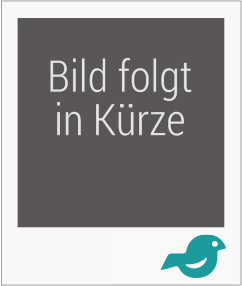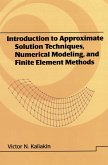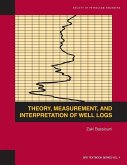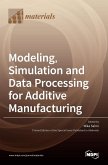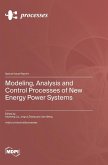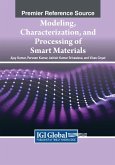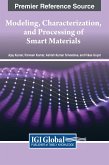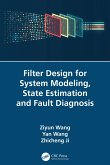Erosion Measurement, Modeling, and Management
Challenges and Solutions
Herausgeber: Towfiqul Islam, Abu Reza Md.; Bhat, Shakeel Ahmad; Kuriqi, Alban
Erosion Measurement, Modeling, and Management
Challenges and Solutions
Herausgeber: Towfiqul Islam, Abu Reza Md.; Bhat, Shakeel Ahmad; Kuriqi, Alban
- Gebundenes Buch
- Merkliste
- Auf die Merkliste
- Bewerten Bewerten
- Teilen
- Produkt teilen
- Produkterinnerung
- Produkterinnerung
Addresses the impact and effects of changing land use and land cover on soil erosion and various methods of assessing erosion as well as ways to control different types of erosion. Use of models such as WEPP model and more are detailed. The book also discusses artificial neural networks, remote sensing data, etc.
Andere Kunden interessierten sich auch für
![Introduction to Approximate Solution Techniques, Numerical Modeling, and Finite Element Methods Introduction to Approximate Solution Techniques, Numerical Modeling, and Finite Element Methods]() Victor N. KaliakinIntroduction to Approximate Solution Techniques, Numerical Modeling, and Finite Element Methods225,99 €
Victor N. KaliakinIntroduction to Approximate Solution Techniques, Numerical Modeling, and Finite Element Methods225,99 €![Theory, Measurement, and Interpretation of Well Logs Theory, Measurement, and Interpretation of Well Logs]() Zaki BassiouniTheory, Measurement, and Interpretation of Well Logs145,99 €
Zaki BassiouniTheory, Measurement, and Interpretation of Well Logs145,99 €![Modeling, Simulation and Data Processing for Additive Manufacturing Modeling, Simulation and Data Processing for Additive Manufacturing]() Modeling, Simulation and Data Processing for Additive Manufacturing77,99 €
Modeling, Simulation and Data Processing for Additive Manufacturing77,99 €![Modeling, Analysis and Control Processes of New Energy Power Systems Modeling, Analysis and Control Processes of New Energy Power Systems]() Modeling, Analysis and Control Processes of New Energy Power Systems107,99 €
Modeling, Analysis and Control Processes of New Energy Power Systems107,99 €![Modeling, Characterization, and Processing of Smart Materials Modeling, Characterization, and Processing of Smart Materials]() Modeling, Characterization, and Processing of Smart Materials187,99 €
Modeling, Characterization, and Processing of Smart Materials187,99 €![Modeling, Characterization, and Processing of Smart Materials Modeling, Characterization, and Processing of Smart Materials]() Modeling, Characterization, and Processing of Smart Materials247,99 €
Modeling, Characterization, and Processing of Smart Materials247,99 €![Filter Design for System Modeling, State Estimation and Fault Diagnosis Filter Design for System Modeling, State Estimation and Fault Diagnosis]() Ziyun WangFilter Design for System Modeling, State Estimation and Fault Diagnosis97,99 €
Ziyun WangFilter Design for System Modeling, State Estimation and Fault Diagnosis97,99 €-
-
-
Addresses the impact and effects of changing land use and land cover on soil erosion and various methods of assessing erosion as well as ways to control different types of erosion. Use of models such as WEPP model and more are detailed. The book also discusses artificial neural networks, remote sensing data, etc.
Produktdetails
- Produktdetails
- Verlag: Apple Academic Press
- Seitenzahl: 294
- Erscheinungstermin: 17. September 2025
- Englisch
- Abmessung: 240mm x 161mm x 20mm
- Gewicht: 608g
- ISBN-13: 9781774916667
- ISBN-10: 1774916665
- Artikelnr.: 73962308
- Herstellerkennzeichnung
- Libri GmbH
- Europaallee 1
- 36244 Bad Hersfeld
- gpsr@libri.de
- Verlag: Apple Academic Press
- Seitenzahl: 294
- Erscheinungstermin: 17. September 2025
- Englisch
- Abmessung: 240mm x 161mm x 20mm
- Gewicht: 608g
- ISBN-13: 9781774916667
- ISBN-10: 1774916665
- Artikelnr.: 73962308
- Herstellerkennzeichnung
- Libri GmbH
- Europaallee 1
- 36244 Bad Hersfeld
- gpsr@libri.de
Abu Reza Md. Towfiqul Islam, PhD, is an Associate Professor in the Department of Disaster Management at Begum Rokeya University, Bangladesh. He has authored one book and several book chapters, published more than 100 peer-reviewed research papers, participated in 10 conferences, and received several awards and recognitions. His research work has been funded by Begum Rokeya University under the University Grants Commission, Govt. of Bangladesh. He is a review editor for Frontiers in Water and guest editor of Frontiers in Climate and has also served as a reviewer for many international reputed journals. Alban Kuriqi, PhD, is a Research Scientist at CERIS-Civil Engineering Research and Innovation for Sustainability, University of Lisbon, Portugal. His expertise focuses on renewable energy, river restoration and management, floods and droughts, hydraulic structures, sustainable drainage systems, long-term meteorological and hydrologic trends and variability analysis, artificial intelligence applications in the field hydraulics and hydrology, etc. He has received scientific awards and fellowship grants. He has co-organized conferences and has published over 100 papers and several book chapters. He is a reviewer for journals and conferences and for Marie Sklodowska-Curie's research proposal grants. Shakeel Ahmad Bhat, PhD, holds a PhD in Soil and Water Engineering from the College of Agricultural Engineering at Sher-e-Kashmir University of Agricultural Sciences and Technology (SKUAST-K), India. He has worked on hydroponics technology during his PhD program. He is an author of several scientific articles and book chapters and three books. He has presented and participated at state, national, and international conferences, seminars, and workshops and is also a reviewer for various international journals. Ahmed Elbeltagi, PhD, is a Researcher in the Agricultural Engineering Department at Mansoura University, Egypt. He was a guest editor for a special issue on water pollution and treatment by the American Journal of Agricultural and Biological Sciences and is a board member of the Journal of Agricultural Studies, American Journal of Agricultural and Biological Sciences, Agricultural Water Management, Computers and Electronic in Agriculture, Advances in Water Resources, Journal of Hydrology, and Water Resources Management. He has published research papers in in the area of water footprint, water management, and hydrologic modeling with machine learning, deep learning, GIS, and RS techniques.
1. Impact of Land Use and Land Cover Changes on Soil Erosion. 2. Role of
Mulching in Reducing Erosion. 3. Assessment and Management of Wind Erosion.
4. Assessing Erosion Using Hypsometric Analysis in the Subarnarekha River
Basin. 5. Runoff and Sediment Monitoring Using the WEPP Model. 6. USLE
Method for Erosion Prediction and Conservation Measures at the Air Dingin
Watershed of the Upstream Part in Padang City, Indonesia. 7. Assessing
Water Erosion Using the Soil Water Assessment Tool (SWAT). 8. Challenges
and Limitations of Using Soil Erosion Models. 9. Mapping Gully Erosion
Susceptibility Using the Bayesian Weight of Evidence. 10. Gully Erosion
Susceptibility Modeling Using Machine Learning Models. 11. Challenges and
Limitations of Using Soil Erosion Models.
Mulching in Reducing Erosion. 3. Assessment and Management of Wind Erosion.
4. Assessing Erosion Using Hypsometric Analysis in the Subarnarekha River
Basin. 5. Runoff and Sediment Monitoring Using the WEPP Model. 6. USLE
Method for Erosion Prediction and Conservation Measures at the Air Dingin
Watershed of the Upstream Part in Padang City, Indonesia. 7. Assessing
Water Erosion Using the Soil Water Assessment Tool (SWAT). 8. Challenges
and Limitations of Using Soil Erosion Models. 9. Mapping Gully Erosion
Susceptibility Using the Bayesian Weight of Evidence. 10. Gully Erosion
Susceptibility Modeling Using Machine Learning Models. 11. Challenges and
Limitations of Using Soil Erosion Models.
1. Impact of Land Use and Land Cover Changes on Soil Erosion. 2. Role of
Mulching in Reducing Erosion. 3. Assessment and Management of Wind Erosion.
4. Assessing Erosion Using Hypsometric Analysis in the Subarnarekha River
Basin. 5. Runoff and Sediment Monitoring Using the WEPP Model. 6. USLE
Method for Erosion Prediction and Conservation Measures at the Air Dingin
Watershed of the Upstream Part in Padang City, Indonesia. 7. Assessing
Water Erosion Using the Soil Water Assessment Tool (SWAT). 8. Challenges
and Limitations of Using Soil Erosion Models. 9. Mapping Gully Erosion
Susceptibility Using the Bayesian Weight of Evidence. 10. Gully Erosion
Susceptibility Modeling Using Machine Learning Models. 11. Challenges and
Limitations of Using Soil Erosion Models.
Mulching in Reducing Erosion. 3. Assessment and Management of Wind Erosion.
4. Assessing Erosion Using Hypsometric Analysis in the Subarnarekha River
Basin. 5. Runoff and Sediment Monitoring Using the WEPP Model. 6. USLE
Method for Erosion Prediction and Conservation Measures at the Air Dingin
Watershed of the Upstream Part in Padang City, Indonesia. 7. Assessing
Water Erosion Using the Soil Water Assessment Tool (SWAT). 8. Challenges
and Limitations of Using Soil Erosion Models. 9. Mapping Gully Erosion
Susceptibility Using the Bayesian Weight of Evidence. 10. Gully Erosion
Susceptibility Modeling Using Machine Learning Models. 11. Challenges and
Limitations of Using Soil Erosion Models.

